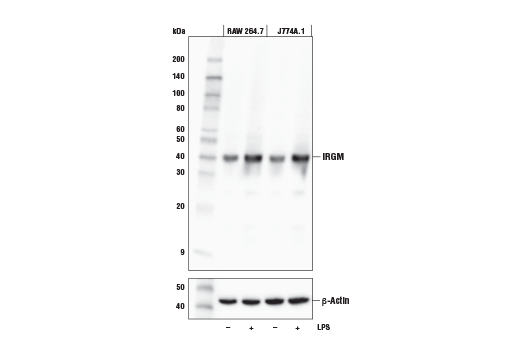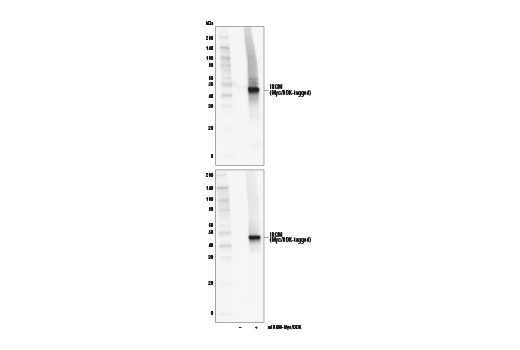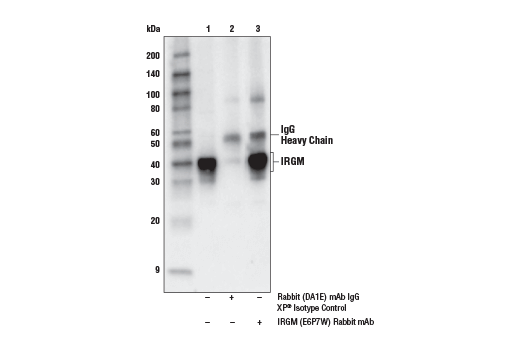WB, IP
M
Endogenous
40
Rabbit IgG
#Q60766
15944
Product Information
Product Usage Information
| Application | Dilution |
|---|---|
| Western Blotting | 1:1000 |
| Immunoprecipitation | 1:100 |
Storage
Specificity / Sensitivity
Species Reactivity:
Mouse
Source / Purification
Monoclonal antibody is produced by immunizing animals with a synthetic peptide corresponding to residues surrounding Ala105 of mouse IRGM protein.
Background
Immunity-related GTPase family M protein 1 (IRGM, LRG-47) belongs to the p47 family of immunity related guanosine triphosphatases (IRGs) that regulate innate immune responses to intracellular pathogens (1-3). Research studies indicate that IRGM plays a role in autophagy during clearance of intracellular bacteria (4). Expression of IRGM in mice, but not in humans, is induced by inflammatory signals that include interferon and LPS (2,3). Polymorphisms in the corresponding IRGM gene are associated with some cases of tuberculosis (5-7), Crohn’s disease (8,9), and severe sepsis (10). Additional studies indicate that IRGM functions through regulation of autophagy (4). Mitochondrial IRGM plays a role in mitochondrial fission, membrane polarization, and mitophagy (11). Knockout mice for IRGM show increased susceptibility to infection as well as intestinal inflammation and Paneth cell abnormalities (12,13). Knockout mice against IRGM are also resistant to neuronal autophagy following stroke (14). RNA viruses commonly target IRGM in order to suppress autophagy and enhance infection (15).
- Kim, B.H. et al. (2012) Cell Host Microbe 12, 432-44.
- Gilly, M. and Wall, R. (1992) J Immunol 148, 3275-81.
- Sorace, J.M. et al. (1995) J Leukoc Biol 58, 477-84.
- Singh, S.B. et al. (2006) Science 313, 1438-41.
- Che, N. et al. (2010) Clin Chim Acta 411, 1645-9.
- Intemann, C.D. et al. (2009) PLoS Pathog 5, e1000577.
- King, K.Y. et al. (2011) PLoS One 6, e16317.
- Parkes, M. et al. (2007) Nat Genet 39, 830-2.
- McCarroll, S.A. et al. (2008) Nat Genet 40, 1107-12.
- Kimura, T. et al. (2014) PLoS One 9, e91522.
- Singh, S.B. et al. (2010) Nat Cell Biol 12, 1154-65.
- Feng, C.G. et al. (2004) J Immunol 172, 1163-8.
- Liu, B. et al. (2013) Am J Physiol Gastrointest Liver Physiol 305, G573-84.
- He, S. et al. (2012) Autophagy 8, 1621-7.
- Grégoire, I.P. et al. (2011) PLoS Pathog 7, e1002422.
Species Reactivity
Species reactivity is determined by testing in at least one approved application (e.g., western blot).
Western Blot Buffer
IMPORTANT: For western blots, incubate membrane with diluted primary antibody in 5% w/v nonfat dry milk, 1X TBS, 0.1% Tween® 20 at 4°C with gentle shaking, overnight.
Applications Key
WB: Western Blotting IP: Immunoprecipitation
Cross-Reactivity Key
H: human M: mouse R: rat Hm: hamster Mk: monkey Vir: virus Mi: mink C: chicken Dm: D. melanogaster X: Xenopus Z: zebrafish B: bovine Dg: dog Pg: pig Sc: S. cerevisiae Ce: C. elegans Hr: horse GP: Guinea Pig Rab: rabbit All: all species expected
Trademarks and Patents
Limited Uses
Except as otherwise expressly agreed in a writing signed by a legally authorized representative of CST, the following terms apply to Products provided by CST, its affiliates or its distributors. Any Customer's terms and conditions that are in addition to, or different from, those contained herein, unless separately accepted in writing by a legally authorized representative of CST, are rejected and are of no force or effect.
Products are labeled with For Research Use Only or a similar labeling statement and have not been approved, cleared, or licensed by the FDA or other regulatory foreign or domestic entity, for any purpose. Customer shall not use any Product for any diagnostic or therapeutic purpose, or otherwise in any manner that conflicts with its labeling statement. Products sold or licensed by CST are provided for Customer as the end-user and solely for research and development uses. Any use of Product for diagnostic, prophylactic or therapeutic purposes, or any purchase of Product for resale (alone or as a component) or other commercial purpose, requires a separate license from CST. Customer shall (a) not sell, license, loan, donate or otherwise transfer or make available any Product to any third party, whether alone or in combination with other materials, or use the Products to manufacture any commercial products, (b) not copy, modify, reverse engineer, decompile, disassemble or otherwise attempt to discover the underlying structure or technology of the Products, or use the Products for the purpose of developing any products or services that would compete with CST products or services, (c) not alter or remove from the Products any trademarks, trade names, logos, patent or copyright notices or markings, (d) use the Products solely in accordance with CST Product Terms of Sale and any applicable documentation, and (e) comply with any license, terms of service or similar agreement with respect to any third party products or services used by Customer in connection with the Products.


